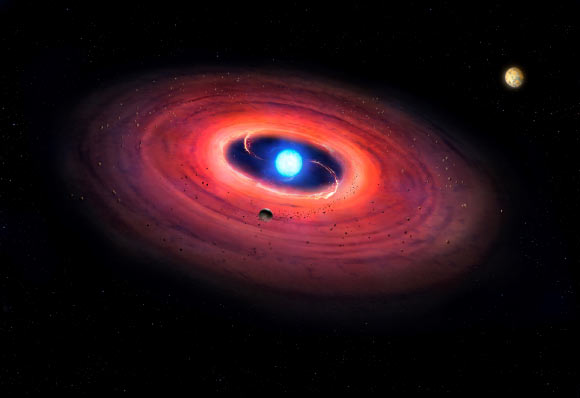Rocky Exoplanets Often Have Earth- and Mars-Like Internal Properties | Astronomy – Sci-News.com
White dwarfs are dense, burned-out remnants of normal stars. Due to their strong gravitational pull, surface atmospheres of these ancient objects should be composed almost entirely of the lightest elements, hydrogen and helium. However, some white dwarfs have atmospheres polluted by heavier elements, including magnesium, iron and oxygen, introduced by rocky exoplanets and asteroids that crashed into the star. Spectroscopic observations of six polluted white dwarfs allowed a team of astronomers from the University of California, Los Angeles and MIT to measure the constituent elements of these extrasolar rocks and determine the abundance of oxidized iron within the rocks. The researchers found that rocky bodies that once orbited these white dwarfs were geophysically and geochemically similar to Earth and Mars.
“By observing white dwarfs and the elements present in their atmosphere, we are observing the elements that are in the body that orbited the white dwarf,” said Alexandra Doyle, a graduate student in the Department of Earth, Planetary, and Space Sciences at the University of California, Los Angeles.
“The white dwarf’s large gravitational pull shreds the asteroid or planet fragment that is orbiting it, and the material falls onto the white dwarf.”
Doyle and colleagues analyzed data from six white dwarfs: SDSS J104341.53+085558.2, SDSS J122859.92+104033.0, SBSS 1536+520, GD 40, SDSS J073842.56+183509.6, and LBQS 1145+0145.
“If I were to just look at a white dwarf star, I would expect to see hydrogen and helium,” Doyle said.
“But in these data, I also see other materials, such as silicon, magnesium, carbon and oxygen — material that accreted onto the white dwarfs from bodies that were orbiting them.”
“When iron is oxidized, it shares its electrons with oxygen, forming a chemical bond between them,” added University of California, Los Angeles Professor Edward Young.
“This is called oxidation, and you can see it when metal turns into rust. Oxygen steals electrons from iron, producing iron oxide rather than iron metal. We measured the amount of iron that got oxidized in these rocks that hit the white dwarf. We studied how much the metal rusts.”
“Rocks from the Earth, Mars and elsewhere in our Solar System are similar in their chemical composition and contain a surprisingly high level of oxidized iron.”
“We measured the amount of iron that got oxidized in these rocks that hit the white dwarf.”
The Sun is made mostly of hydrogen, which does the opposite of oxidizing — hydrogen adds electrons.
The oxidation of a rocky planet has a significant effect on its atmosphere, its core and the kind of rocks it makes on its surface.
“All the chemistry that happens on the surface of the Earth can ultimately be traced back to the oxidation state of the planet,” Professor Young said.
“The fact that we have oceans and all the ingredients necessary for life can be traced back to the planet being oxidized as it is. The rocks control the chemistry.”
Until now, scientists have not known in any detail whether the chemistry of rocky exoplanets is similar to or very different from that of the Earth.
“How similar are the rocks the researchers analyzed to rocks from the Earth and Mars? Very similar,” Doyle said.
“They are Earth-like and Mars-like in terms of their oxidized iron. We’re finding that rocks are rocks everywhere, with very similar geophysics and geochemistry.”
The study was published in the journal Science.
_____
Alexandra E. Doyle et al. 2019. Oxygen fugacities of extrasolar rocks: Evidence for an Earth-like geochemistry of exoplanets. Science 366 (6463): 356-359; doi: 10.1126/science.aax3901







